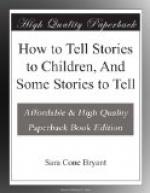HOW WE CAME TO HAVE PINK ROSES[1]
[Footnote 1: Told me by Miss Elizabeth McCracken.]
Once, ever and ever so long ago, we didn’t have any pink roses. All the roses in the world were white. There weren’t any red ones at all, any yellow ones, or any pink ones,—only white roses.
And one morning, very early, a little white rosebud woke up, and saw the sun looking at her. He stared so hard that the little white rosebud did not know what to do; so she looked up at him and said, “Why are you looking at me so hard?”
“Because you are so pretty!” said the big round sun. And the little white rosebud blushed! She blushed pink. And all her children after her were little pink roses!
RAGGYLUG[2]
[Footnote 2: Adapted from Mr Ernest Thompson Seton’s Wild Animals I have known. (David Nutt, 57-59 Long Acre, W.C. 6s. net.)]
Once there was a little furry rabbit, who lived with his mother deep down in a nest under the long grass. His name was Raggylug, and his mother’s name was Molly Cottontail. Every morning, when Molly Cottontail went out to hunt for food, she said to Raggylug, “Now, Raggylug, lie still, and make no noise. No matter what you hear, no matter what you see, don’t you move. Remember you are only a baby rabbit, and lie low.” And Raggylug always said he would.
One day, after his mother had gone, he was lying very still in the nest, looking up through the feathery grass. By just cocking his eye, so, he could see what was going on up in the world. Once a big blue-jay perched on a twig above him, and scolded someone very loudly; he kept saying, “Thief! thief!” But Raggylug never moved his nose, nor his paws; he lay still. Once a lady-bird took a walk down a blade of grass, over his head; she was so top-heavy that pretty soon she tumbled off and fell to the bottom, and had to begin all over again. But Raggylug never moved his nose nor his paws; he lay still.
The sun was warm, and it was very still.
Suddenly Raggylug heard a little sound, far off. It sounded like “Swish, swish,” very soft and far away. He listened. It was a queer little sound, low down in the grass, “rustle—rustle—rustle”; Raggylug was interested. But he never moved his nose or his paws; he lay still. Then the sound came nearer, “rustle—rustle—rustle”; then grew fainter, then came nearer; in and out, nearer and nearer, like something coming; only, when Raggylug heard anything coming he always heard its feet, stepping ever so softly. What could it be that came so smoothly,—rustle—rustle—without any feet?
He forgot his mother’s warning, and sat up on his hind paws; the sound stopped then. “Pooh,” thought Raggylug, “I’m not a baby rabbit, I am three weeks old; I’ll find out what this is.” He stuck his head over the top of the nest, and looked—straight into the wicked eyes of a great big snake. “Mammy, Mammy!” screamed Raggylug. “Oh, Mammy, Mam—” But he couldn’t scream any more, for the big snake had his ear in his mouth and was winding about the soft little body, squeezing Raggylug’s life out. He tried to call “Mammy!” again, but he could not breathe.




